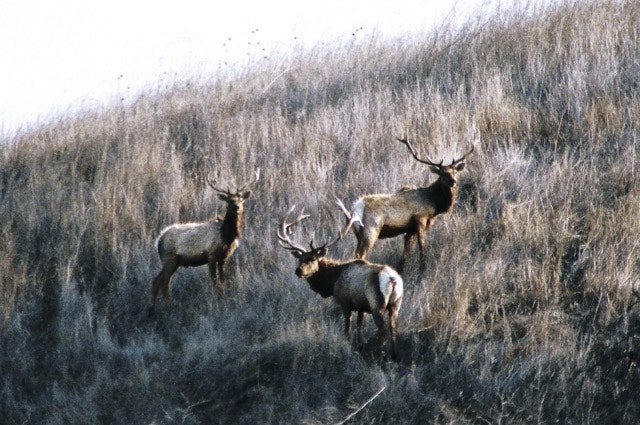Santa Clara County's Tule Elk
Our RCD has been working to increase public and scientific knowledge of Santa Clara County's regional herds of Tule elk since 2014. Early District efforts focused on providing public education and increasing awareness through wildlife workshops and presentations. Under the guidance of Dr. Richard Lanman, District President Emeritus and current Associate Director, the District has since launched a number of scientific research projects that have helped expand the regional knowledge base and will contribute to state and regional efforts to preserve elk habitat and connectivity within California.

Potential Benefits of Elk Herds
1. Elk are charismatic megafauna that have aesthetic and tourism value.
- Oregon’s Jewell Meadows Wildlife Area feeds elk in winter for $200K, but draws $6.5 million in elk viewing tourism. (Donovan and Champ 2009. The Economic Benefits of Elk Viewing. Human Dimensions of Wildlife 14:51-60)
2. Elk are California’s natural grazers and, like cattle, maintain low fuel loads after fires (pyric herbivory).
- Fires had lower spread rates and flames were 3x lower in areas maintained by large ungulates in previously burned southern plains. (Starns et al. 2019. Recoupling fire and grazing reduces wildland fuel loads on rangelands. Ecosphere 10(1):1-15)
3. Elk help to maintain open grasslands by decreasing shrub cover, and also significantly reduced the abundance and biomass of a highly invasive exotic grass, Holcus lanatus at Tomales Point at Pt. Reyes. (Johnson and Cushman. Impacts of Reintroduced Elk on Plant Communities. Conservation Biology 21(2): 515–526)
4. Elk are a preferred prey item for puma and wolves, coyotes and bears take their calves, and elk carcasses are important to the diet of scavengers, particularly California condors who rely today on supplemental feeding stations because of diminished megafauna populations. (Emslie. 1978, Age and Diet of Fossil California Condors in Grand Canyon, Arizona. Science 237:768-770)
The District began a new research project in 2023 in collaboration with Santa Clara University, the University of Oklahoma and the Muwekma Ohlone Tribe of the San Francisco Bay Area to develop and implement an ancient DNA sequencing protocol designed to determine the genetic similarity of historic and prehistoric elk in the south and west San Francisco Bay Region.

Publications
Review of considerations for restoration of tule elk to the San Francisco Peninsula and northern Monterey Bay counties of California; California Department of FIsh and Wildlife Journal, Volume 108 Issue 3 ; Proceedings of the 14th Biennial Deer and Elk Workshop; October 12, 2022; Publication link
Richard B. Lanman, Institute for Historical Ecology; Guadalupe-Coyote Resource Conservation District
William C. Keikam, Urban Wildlife Research Project; Guadalupe-Coyote Resource Conservation District
Monica V. Arellano, Muwekma Ohlone Tribe
Alan Levanthal, Muwekma Ohlone Tribe; San Jose State University, Department of Anthropology
Valentin Lopez, Amah Mutsun Tribal Band
Ryan A. Phillips, Talon Ecological Research Group
Julie A. Phillips, Nature Based Teaching
Kristin Denryter, CDFW, Game Conservation Program; Alaska Department of Fish and Game (current affiliation)
*****************
Road and highway undercrossings as potential critical linkages for California’s elk populations; California Department of FIsh and Wildlife Journal, Volume 108 Issue 3 ; Proceedings of the 14th Biennial Deer and Elk Workshop; October 12, 2022; Publication link
Richard B. Lanman, Institute for Historical Ecology and Guadalupe-Coyote Resource Conservation District
James Kilber, Fort Hunter Liggett and Colorado State University Center for Environmental Management of Military Lands
Jeff Cann, California Department of Fish and Wildlife, Central Region
Carrington Hilson, California Department of Fish and Wildlife, Northern Region
Erin Zulliger, California Department of Fish and Wildlife, Northern Region
Joshua Bush, California Department of Fish and Wildlife, North Central Region
Floyd W. Weckerly, Department of Biology, Texas State University
Thomas J. Batter, California Department of Fish and Wildlife, Game Conservation Program, Wildlife Branch
